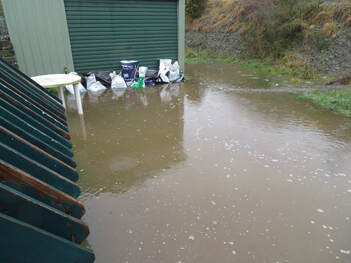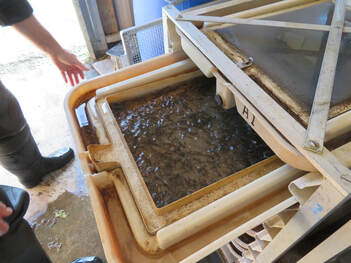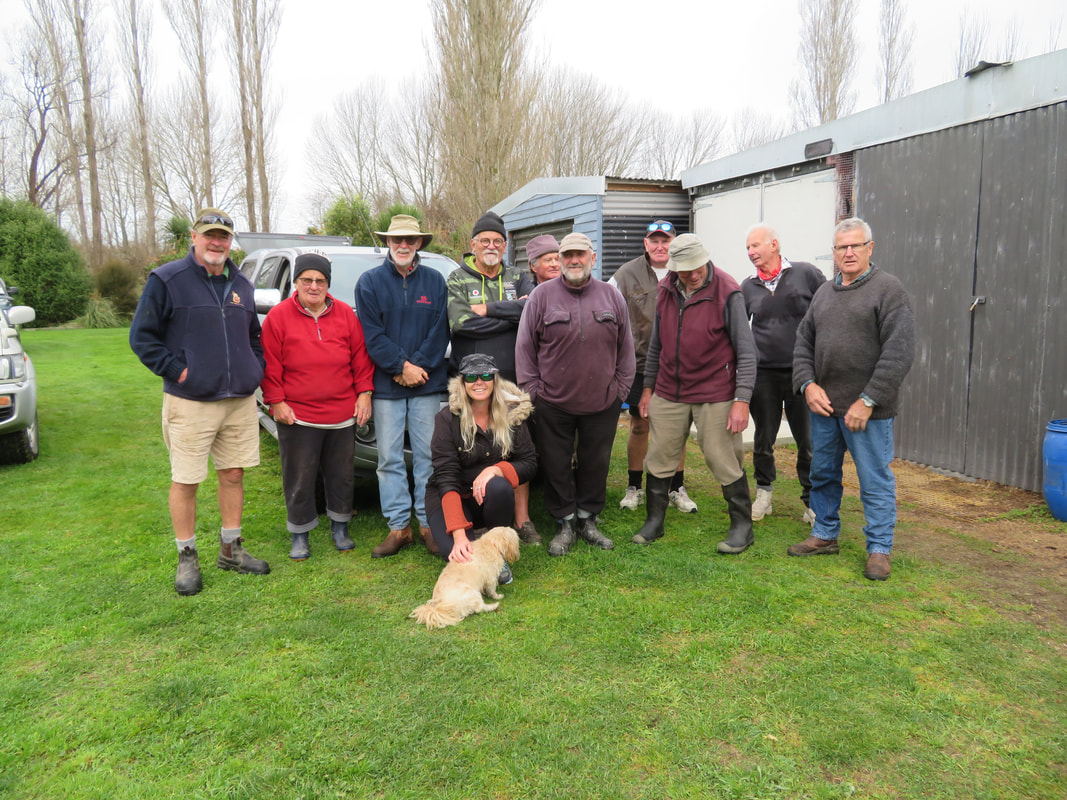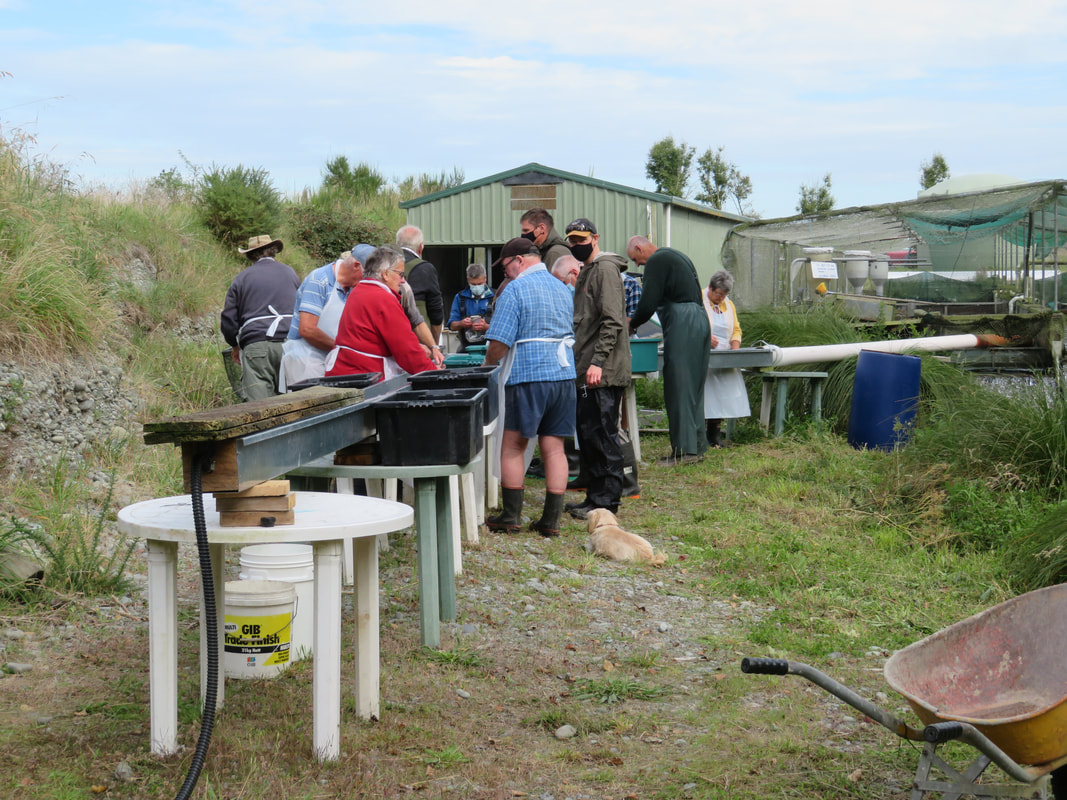|
The following note has been compiled by Alan Brooks who is working closely, along with Paul Hodson, with RDR Management to confirm that the return stream from the fish screen, is fit for purpose and will return small migrating fish safely back to the river.
Fish Screen RDR. You will be aware that the Project has been switched over with the Fish screens and bypass operational. We were invited to a workshop in 6/2022 by RDR in which this was the first time that we received plans for the actual bypass. We had a critical look at all sections and made our views known to them. There are a number of concerns that we have expressed.
***************************************** And now for the Great News - Salmon Legacy for Future Generation Please refer to the attached table which I believe establishes a Conservative Estimate of Smolt to Sea in Year 2022. I believe this the best news we have heard for years and will start our Legacy that we have cried out for and all but given up on. Mark these dates down on your Diary and tell all you fellow anglers to get ready. Year 2022, this year 1.5million smolt will get to sea from the Rangitata. Fishing season Year2022/23 we should see and increase year1 precocious Males Fishing season Year2023/24 an increase in 2 years old fish Fishing season Year2024/25 we are could get up to 10,000 but le us assume 4,000+ or more Adult returns Logically the majority will return to the Rangitata, but it will also support the Opihi and Orari Rivers. So, mark those dates and watch this space. See table below for our calculations. Rangitata River Projected River Hatch and Smolt to Sea, Year 2022 Alan Brooks Dated 8/21/2022 Totals [1] Adult Salmon to Headwaters CSIFG 1800 [2] Females Run Mix 60% 1080 [3] Egg count Conservative 3000 per Female 3240000 [4] Headwaters Hatch 50% 1620000 [5] Estimated loss to sea 10% 1458000 ****RDR now clear*** [6] Say 1.5Million ************************************** Rangitata Prior 3 Years [1] Adult Maximum 500 [2] Females Run Mix 60% 300 [3] Egg count Conservative 3000 per Female 900000 [4] Headwaters Hatch 50% 450000 [5] RDR Losses 50% min 225000 [5] Estimated loss to sea 10% 202500 [6] Say 203000 ************************************** Summary to Sea Year 2022 1500000 Prior 3 year average 203000 Increase 7.389162562 Times
0 Comments
Work continues at the hatchery with things progressing well out there. McKinnons creek has had a good flow and the Rangitata river is not far from its confluence with the hatchery stream. All good indications for good access to and from the hatchery for (Scientific name) Oncorhynchus tshawytscha.
The fry, at present in the hatchery shed and starting to put on weight with an average weight of around 1.2gms. A big thank you to all those who have helped out including the weekend teams over the winter. A quick summary of statistics is as follows; Adult Salmon returns to McKinnons Creek 2022 inc other data. Males. Non fin clipped. 6. Males. Fin clipped. 6. Females Non fin clipped. 7. Females. Fin clipped 18 Approx 10 small Jack fish returned to creek. Egg stripping started 3/5/22. Completed 17/5/22. 43 female fish were processed, being almost a 50/50 ratio of returnees to the hatchery and 3yr old land based broodstock to produce approx. 120,000 eggs. 120 x 3yr old land based broodstock fish, not used were returned to McKinnons creek. This was 20 males and approx. 100 females. 1yr old fish released 2022. 4000 to McKinnons creek 13/7/22 400 kept back for brood stock 13/7/22 1000 to RDR for testing/release. As at 6th September we are holding approx. 95,000 fry average weight 1 gram. 5000m of these are from non clipped females crossed with non clipped males (P1). These are kept separate. The remainder are a mix of P2, P3, P4, P5. A number of fish have been observed spawning in McKinnons creek and a number of Reeds have been spotted. All hatched salmon fry have now been removed from the incubators and put in stainless steel tanks inside the hatching shed and in the outside SS tank (No 4). Our best guess count is 95,000 young fish. All have had their 1st feed and are getting used to swimming freely in their environment.
All the remaining 1 year old fish have been released except a small number for possible future broodstock. Recently there has been two occasions when water from the flooded creek has gone through the shed despite our sandbagging efforts. No damage done but its becoming a bit of a pain every time we get heavy rain. The AGM went well with plenty of discussion and a quick breakdown of the past year at the hatchery. Welcome to new committee members Barry Gregan, Ray Hill and Duncan Grant and a big thank you for great service from retiring members Raylene and Robert Clarke and Tim Wakefield. The Chairmans report to the AGM is attached below.
The Hatchery group (Salmon and Riparian Support Trust) will have its AGM on Wednesday 20th July at 7.00pm at CSI Fish and Game rooms in Temuka. Come along and get the latest about the hatchery.
The first 4 trays of eggs that were put down on the 3rd of May were starting to hatch on the 14th June. These were from unclipped salmon that returned to the hatchery and were either wild strays or were hatched in McKinnon's creek itself. These number about 4500 and some of this group will be kept for brood stock for the future.
As of 22nd May, 5 out of the 6 incubator stacks have eggs hatching out. There have bee some mortality in the eggs but not unexpected numbers and not significant. We expect more than 100,000 fish to survive. Filtering the creek water through the shed and still keeping a good flow is still a challenge and the amount of silt going through is an eternal problem. The egg pickers have done a great job. Next year's 3 year old brood stock were transferred to the North race after it was cleaned out and some maintenance carried out. Hatchery volunteer John Manning built a new stainless steel screen which was installed and will be a big help separating age groups. Thanks go to all those volunteers who helped over the last year. Click photos to enlarge. Reprinted from "Courier" article.
Volunteers at the McKinnon’s Creek salmon hatchery at Rangitata were hard at it again on Tuesday 17th for their final day fish stripping and fertilization of this year’s salmon eggs. The fertilized eggs are subsequently installed in special incubating trays where they remain for roughly 80 days after hatching and absorbing their eggs sac to becoming fully fledged salmon fry. It’s a very busy time at the hatchery at present says Phil deJoux who is the Chairperson of the group that operate the hatchery. Once hatched, the fish will be kept at the hatchery for approximately one year before being released back in to the Rangitata river. They will then spend 2 years at sea growing to around 7 or 8 Kilos under ideal conditions, before returning to the river for anglers to catch. Some will return to the hatchery to become brood stock for the future. Volunteers at the hatchery are mostly retired and enjoy the variation of tasks required to operate a modern hatchery. Over the past 2 years, the hatchery has upgraded all of its SOPs, Biosecurity measures, Health and Safety plans and a host of other requirements to be able to keep operating. The hatchery which started in 2006, enjoys wide support from the community and is playing its part in providing an increased opportunity for anglers to catch a salmon in the Rangitata river during the fishing season. Recently it has been involved with assisting the Winnemem Wintu Indian tribe of North America with genetic data from local fish populations in conjunction with CSI Fish and Game. Phil reports that around 221,000 salmon eggs are under incubation at the hatchery which augers well for future salmon seasons on the Rangitata. The next big focus is picking over the 221,000 eggs to remove any dead ones from the incubation trays. This is a time consuming job but it’s a great chance for a chat and a catch up over the winter with our volunteers. Anyone wishing to become involved should contact Phil on 0274422454 By all accounts more wild Salmon came in to the Rangitata in November/December this season than has been the case for the last few years. Unfortunately the river was a bit clouded for good fishing and they got well up river before the river cleared.
More fish have returned to the hatchery as well and so far we have had around 25 through the trap. This is many more than last year. We have got our fingers crossed that we have bottomed out in terms of poor returns. With our land based brood stock and fish that have returned, we should reach our goal of 110,000 fry for this year. This will still be a challenge for our small band of dedicated volunteers but we are still all passionate about the project. We need help, if anyone is available please let us know. Call 0274422454 if this plea finds favor with you or someone you may know. We have 6000 almost yearling fry ready to release back to the river however 500 of these will be used to test the by-pass at the new RDR fish screen. These will be released up river and checked once they have passed the screen to check that they have got passed un-damaged. Its in all our interests to make sure this by-pass is working effectively. The scheme should be commissioned around September by all accounts. The few hatchery volunteers that we have are once again facing a busy year with the prospect of reasonable numbers of fish returning to the hatchery to be part of the program along with 3 year old brood stock fish held at the hatchery. Help at the hatchery has waned in the last couple of years which can be put down to negative comments from a few individuals and the fact that our helpers are all getting on in years and the continued commitment is taking its toll.
The hatchery at McKinnon's creek was set up initially to bring more salmon back to the Rangitata river, and others, for anglers to catch and this remains true today. Unfortunately returns to the hatchery have dwindled in the past few years along with salmon in other Canterbury rivers and this has also contributed to volunteers deciding not to carry on. This of course is understandable however the upshot is that we either shut up shop altogether or urgently attract more passionate individuals to help with the day to day running of the hatchery. The McKinnon's Creek hatchery has a future and there are a number of possibilities down the track that will secure this, but we must have more help. A new volunteer recently to the hatchery when asked why he came out to help stated that anyone doing something to help save the salmon run, is worth supporting. A great sentiment. At present we have around 6000 fish to release later in the year when ideal conditions prevail. These fish were fin clipped a few days ago. Many thanks to those who were asked and came along to help. A big thanks also to those individuals who helped with the Winnemem Wintu Salmon sampling program last winter. This program was to help with genetic matching of salmon in NZ for the North American First nation people and done in conjunction with CSI Fish & Game. The tribe made a financial donation to our hatchery for our help which was gratefully received and we have communicated to them our thanks. If anyone can help us in the future please contact Phil (0274422454) or Alan (033392139). Helpers need to be relatively close to the area (Timaru - Ashburton) and be prepared to travel to the hatchery on the lower Rangitata river, South side. Full training will be given and an interesting and worthwhile experience is assured. |
Archives
March 2024
Categories |
||||||
























